Eco Friendly Food Packaging: Green is the New Black
Are you tired of harmful plastics suffocating our planet? Well, get ready to join the green movement because eco-friendly food packaging is here to save the day!
In this article, we’ll explore the significance of sustainable packaging and introduce you to a wide range of environmentally friendly alternatives. Say goodbye to conventional plastics and hello to glass containers, stainless steel, bamboo, rice husk, and gelatin films.
Let’s work together to create a future where green is the new black in food packaging!
Key Takeaways
- Plastics pose risks to the environment and human health, including the accumulation of plastics in oceans and landfills, generation of micro- and nanoplastics, and transfer of chemicals from packaging to food.
- Eco-friendly packaging materials such as glass containers, stainless steel, bamboo, rice husk, and gelatin films offer sustainable alternatives to conventional plastics.
- It is important to avoid certain types of plastics, such as those containing harmful additives, single-use plastics, plastics with BPA, and plastic takeout containers.
- Tips to cut down on plastic packaging include using reusable metal or bamboo straws, choosing nonplastic or BPA-free alternatives, and being conscious of reducing plastic packaging in daily life.
Significance of Eco Friendly Food Packaging
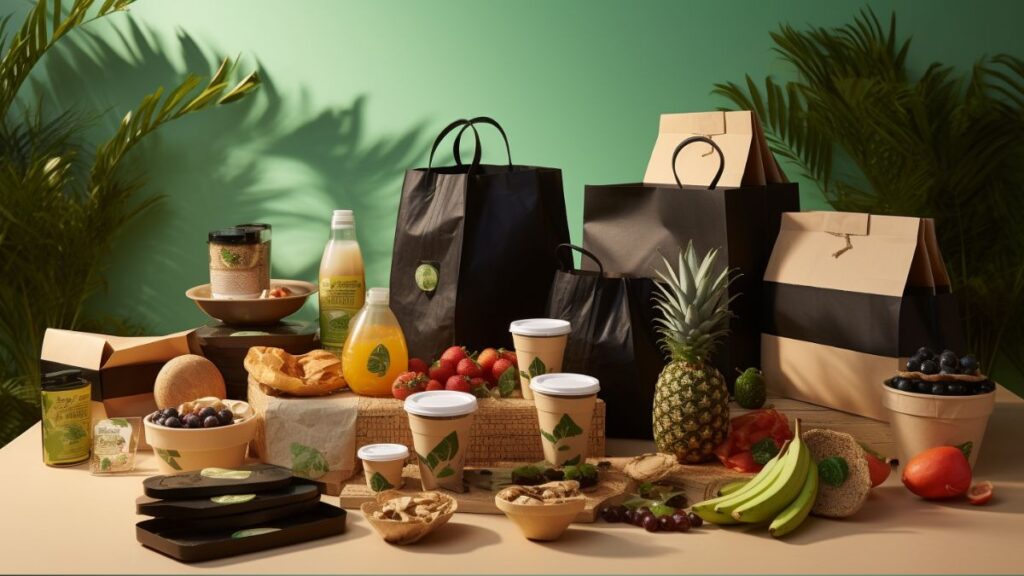
Plastics pose risks to the environment and human health, which emphasizes the significance of sustainable food packaging. Eco-friendly food packaging is an essential step towards a green future.
By opting for sustainable packaging materials, we can reduce the negative impact of plastics on our planet. Glass containers are a great eco-friendly alternative, as they are reusable, recyclable, durable, and have a longer lifespan than plastic. Stainless steel containers are another excellent option, being rust-free, heat resistant, and safe for food storage.
Bamboo, although less durable than glass or stainless steel, is biodegradable and suitable for certain food packaging needs. Rice husk is a low-cost, renewable material that absorbs pollutants from the environment, making it a viable alternative for eco-friendly food packaging.
Embracing these eco-friendly packaging materials paves the way for a greener and more sustainable future.
Embracing Eco-Friendly Packaging Materials
Glass containers are a durable and long-lasting alternative to plastic packaging materials. When it comes to eco-friendly packaging materials, glass containers are a top choice for food storage and small businesses alike. Not only are they reusable and recyclable, but they are also easy to clean and transport food. Some containers even come with leak-free lids, ensuring that your meals stay fresh and secure.
In fact, the lifespan of glass containers is 3.5 times longer than plastics, making them a sustainable option for your packaging needs. So whether you’re looking for custom eco-friendly packaging or simply want to make your own eco-friendly food packaging, glass containers are a reliable and eco-conscious choice.
Now, let’s explore the types of plastic to steer clear from and why they pose risks to the environment and our health.
Types of Plastic to Steer Clear From
When it comes to choosing packaging materials, you should avoid using certain types of plastic due to their harmful additives and inability to decompose naturally. Conventional plastics contain harmful additives and do not break down into natural substances, increasing the risk of pollution and endocrine disorders.
Single-use plastics, such as straws, beverage bottles, bottle caps, Styrofoam cups, and plastic bags, accumulate in oceans and coastal areas, contributing to waste and pollution. Plastics with BPA, used in polyvinyl chloride (PVC) plastic products, can accumulate in the environment and migrate to food, increasing the risk of infertility and metabolic disorders.
Plastic takeout containers are also a widespread source of waste and pollution, with negative consequences for the environment and human health. To minimize plastic packaging, consider using reusable metal or bamboo straws, choosing nonplastic or BPA-free alternatives, and being conscious of reducing plastic packaging in daily life.
Practical Tips to Minimize Plastic Packaging
To cut down on plastic packaging, it’s important to make conscious choices and opt for reusable alternatives. By choosing reusable metal or bamboo straws instead of single-use plastic straws, you can reduce plastic waste. Clean these straws with brushes for hygienic maintenance.
When it comes to food storage, choose non-plastic or BPA-free alternatives. Glass containers are a great option as they are durable, recyclable, and easy to clean. Stainless steel containers are also a good choice, being rust-free and heat resistant. Bamboo containers are biodegradable, although less durable than glass or stainless steel. Rice husk lunch boxes are another alternative, being low-cost and biodegradable.
By being conscious of reducing plastic packaging in your daily life, you can make a positive impact on the environment.
Next, let’s explore companies that are promoting eco-friendly packaging solutions.
Also Read: Eco-Friendly Kitchen Products: Revolutionary Kitchen for A More Sustainable Lifestyle.
Spotlight on Companies Promoting Eco Friendly Food Packaging
One company leading the way in eco-friendly packaging solutions is BioPak. They are committed to providing sustainable alternatives to traditional packaging materials.
BioPak offers a range of cups, containers, and more that are made from rapidly renewable resources and plant-based plastics. By using these eco-friendly options, you can contribute to reducing the detrimental impact of petroleum-based plastics on the environment.
Petroleum-based plastics accumulate in landfills and oceans, posing risks to both the ecosystem and human health. These plastics do not decompose into natural substances and break down into micro- and nanoplastics, increasing the risk of pollution and endocrine disorders.
The Detrimental Impact of Petroleum-Based Plastics
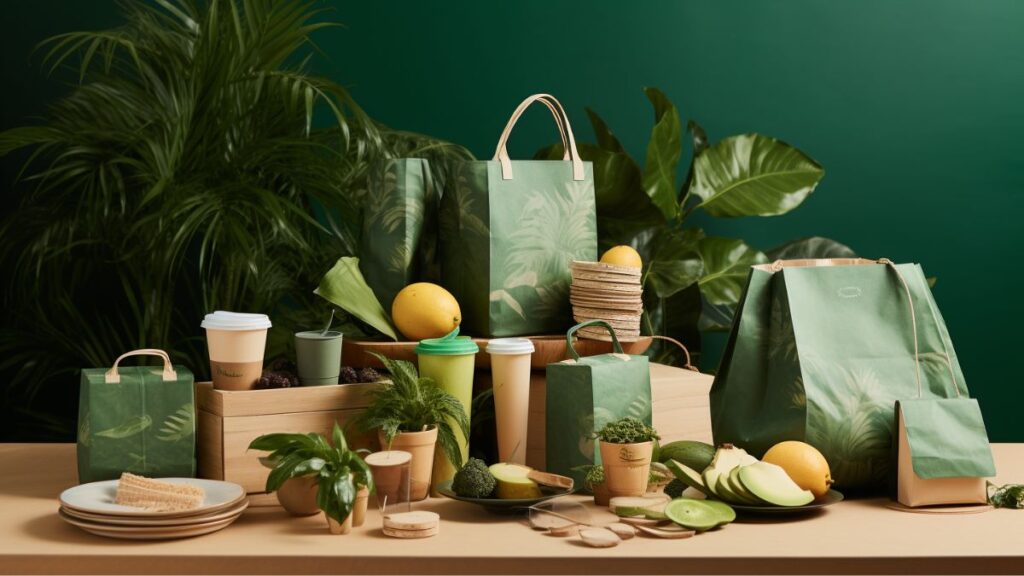
Now that you understand the importance of sustainable food packaging and have learned about various eco-friendly packaging materials, let’s delve into the detrimental impact of petroleum-based plastics.
It’s crucial to be aware of the harmful effects these plastics have on the environment and human health. Here are some key points to consider:
- Accumulation of plastic in the environment leads to pollution and harm to wildlife.
- Petroleum-based plastics do not decompose naturally, resulting in long-term environmental damage.
- These plastics can break down into microplastics and nanoplastics, which further pollute ecosystems.
- Exposure to chemicals from plastic packaging, such as Bisphenol A (BPA), can increase the risk of health issues like infertility and metabolic disorders.
Understanding the negative consequences of petroleum-based plastics is vital in promoting the use of alternative, eco-friendly packaging solutions.
Innovative Plastic Packaging Solutions by ALPLA
When looking for innovative plastic packaging solutions, ALPLA offers a wide range of systems, bottles, closures, and molded parts. With their commitment to recycling plastics and resource-efficient production, ALPLA is a leading provider of sustainable packaging solutions.
Their established customer base includes Werner Mertz (Frosch) and Arca Food UK’s Eco Bottle, showcasing their expertise and trustworthiness in the industry. ALPLA understands the importance of reducing the environmental impact of plastic packaging and strives to offer eco-friendly alternatives.
They continuously research and develop new materials and technologies to improve sustainability. By choosing ALPLA, you can be confident that you are contributing to a greener future and making a positive impact on the environment.
Now, let’s explore another pioneering natural and biodegradable packaging solution: Arekapak.
Arekapak: Pioneering Natural and Biodegradable Packaging
You can make a sustainable choice by considering Arekapak, a pioneering natural and biodegradable packaging solution. Arekapak is a start-up based in Berlin that develops packaging made from sun-dried areca palm leaves. These packaging materials are 100% biodegradable and chemical-free, making them a great alternative to traditional plastic packaging.
Not only are they eco-friendly, but they also require little water and energy for production. Arekapak’s packaging is stable, heat and cold resistant, and water-repellent, making it suitable for a variety of food packaging needs.
By choosing Arekapak, you are actively reducing your environmental footprint and contributing to a healthier planet.
Now, let’s explore another innovative solution in the world of eco-friendly packaging: compostable packaging materials, with a focus on Bio Futura.
Compostable Packaging Materials: A Focus on Bio Futura
Bio Futura is an international team that specializes in developing compostable packaging materials as sustainable alternatives to traditional plastic disposable tableware. They are at the forefront of the eco-friendly packaging industry, offering innovative solutions to reduce plastic waste and promote a greener future.
Here is a table showcasing some of the compostable packaging materials offered by Bio Futura:
| Material | Features | Benefits |
|---|---|---|
| Sugarcane | Made from renewable resources | Biodegradable and compostable |
| Aluminum | 100% recycled | Lightweight and durable |
| PLA | Derived from cornstarch | Completely compostable |
| Palm leaf | Natural and chemical-free | Heat-resistant and water-repellent |
| Bagasse | Made from sugarcane fiber | Sturdy and suitable for hot and cold food |
With Bio Futura’s compostable packaging materials, you can enjoy the convenience of disposable tableware while minimizing your environmental impact. Now, let’s explore eco-friendly packaging alternatives with Biopak, another leading company in the industry.
Exploring Eco Friendly Food Packaging Alternatives With Biopak
Biopak offers a wide range of cups, containers, and more as alternatives to traditional paper and plastic packaging. With a focus on sustainability, Biopak aims to provide eco-friendly packaging options that reduce the environmental impact of foodservice operations.
Their products are made from rapidly renewable resources and plant-based plastics, making them a greener choice for businesses and consumers alike. Biopak’s commitment to sustainability extends beyond their products, as they also prioritize responsible sourcing and manufacturing practices.
By choosing Biopak’s eco-friendly packaging solutions, you can contribute to a more sustainable future and reduce your carbon footprint. Transitioning to eco-friendly packaging is a small yet impactful step towards creating a more environmentally conscious food industry.
Now, let’s explore the rise of paper-based packaging with Ecopack.
The Rise of Paper-Based Packaging With Ecopack
Now, let’s delve into the growing popularity of paper-based packaging with Ecopack.
With the increasing demand for eco-friendly food packaging, paper-based options have gained significant traction. Here are five reasons why paper-based packaging from Ecopack is becoming a favorite choice for environmentally-conscious individuals:
- Sustainable Solution: Paper-based packaging is recyclable and biodegradable, making it a sustainable alternative to traditional plastic packaging.
- Reduced Environmental Impact: Paper-based packaging helps minimize the accumulation of plastic waste in landfills and oceans, protecting the environment and marine life.
- Versatility: Ecopack offers a wide range of paper-based packaging solutions, including baking molds and packaging materials suitable for various food products.
- Commitment to Environmental Standards: Ecopack invests in research and development to ensure its packaging meets high environmental standards, providing customers with reliable and eco-friendly options.
- Global Presence: With facilities in multiple countries, including Turin, Brazil, Canada, India, Russia, and Tunisia, Ecopack is accessible to a wide range of customers worldwide.
As we explore the innovative world of sustainable packaging, let’s now transition into the next section about ‘notpla: revolutionizing seaweed-based packaging.’
NotPla: Revolutionizing Seaweed-Based Packaging
Now that you have learned about the rise of paper-based packaging with Ecopack, let’s explore another innovative solution in the world of eco-friendly food packaging: NotPla.
NotPla, developed by Skipping Rocks Lab, is revolutionizing the industry with its 100% natural, biodegradable, and edible packaging made from seaweed. By harnessing the sustainable growth of algae, NotPla offers a range of products including cups, bottles, and sachets that disappear naturally within weeks.
This seaweed-based packaging provides a viable alternative to traditional plastics, reducing the accumulation of harmful waste in our environment. NotPla’s commitment to sustainability aligns with the growing demand for eco-friendly packaging options.
As we continue our exploration of sustainable food packaging, let’s now turn our attention to Oceanium, a Scotland-based start-up that is merging seaweed-based packaging with food products.
Oceanium: Merging Seaweed-Based Packaging and Food Products
Oceanium, a start-up based in Scotland, is combining seaweed-based packaging with the production of food and nutrition products. This innovative approach not only offers eco-friendly packaging solutions but also promotes sustainable consumption. Here are four reasons why you should be excited about Oceanium’s seaweed-based packaging:
- Environmentally friendly: Seaweed-based packaging is biodegradable, meaning it breaks down naturally without leaving harmful residues. By choosing this packaging, you contribute to reducing plastic waste and protecting the environment.
- Nutritional benefits: Seaweed is a rich source of vitamins, minerals, and antioxidants. By incorporating it into food and nutrition products, Oceanium provides you with a sustainable and nutritious option.
- Home compostable: Oceanium’s seaweed-based packaging is designed to be compostable in home composting systems. This makes it convenient for consumers who want to dispose of packaging in an environmentally responsible way.
- Supporting local communities: Seaweed farming supports coastal communities by providing income and employment opportunities. By choosing Oceanium’s products, you contribute to the growth and development of these communities.
Now, let’s explore another sustainable packaging solution: paptic, a viable alternative to plastic films.
Paptic: A Viable Alternative to Plastic Films
Paptic offers a sustainable and flexible packaging material that serves as a viable alternative to traditional plastic films. Their innovative solution helps address the environmental concerns associated with plastic packaging.
Their material is made from renewable and biodegradable raw materials, making it a more eco-friendly choice. It provides greater durability and flexibility than paper, making it suitable for various industries, including consumer electronics and fashion.
By choosing Paptic, you can contribute to reducing plastic waste and protecting the environment. Take a look at the table below for a quick comparison between Paptic and traditional plastic films:
| Paptic | Traditional Plastic Films |
|---|---|
| Sustainable and biodegradable | Non-biodegradable |
| Flexible and durable | Less flexible and prone to tearing |
| Made from renewable raw materials | Made from fossil fuels |
| Environmentally friendly | Contributes to plastic waste |
Now, let’s explore how Repaq is leading the way in recyclable and compostable packaging solutions.
Repaq: Leading the Way in Recyclable and Compostable Packaging Solutions
If you’re looking for a sustainable and environmentally conscious packaging solution, Repaq is leading the way in recyclable and compostable options. Here’s why they should be on your radar:
- Repaq offers a range of packaging solutions that are not only recyclable but also compostable. By choosing their products, you can have peace of mind knowing that you are contributing to the reduction of waste in landfills and promoting a healthier environment.
- Their packaging is made from a film composite that includes cellulose, water, glycerin, and binders. These materials are not only biodegradable but also printed with water-based inks, making them a safer alternative to traditional plastics.
- Repaq’s product range includes pouches, stick packs, and flow packs suitable for food packaging. Whether you’re in the food industry or simply want to make a more sustainable choice for your household, Repaq has you covered.
By opting for Repaq’s recyclable and compostable packaging solutions, you can play your part in creating a greener future.
Now, let’s explore renewable packaging solutions by Storaenso.
Renewable Packaging Solutions by Storaenso
Storaenso understands the importance of renewable packaging solutions in today’s world. They offer innovative solutions for industries like food, cosmetics, pharmaceuticals, and textiles, providing low-carbon alternatives to fossil-based products. By prioritizing sustainability and renewable materials, Storaenso is making a positive impact on the environment.
Their commitment to developing eco-friendly packaging options aligns with your values as someone who desires belonging to a community of individuals who care about the planet. Moving away from fossil-based products and choosing renewable packaging helps reduce our carbon footprint and minimize the negative impact on the environment.
By investing in Storaenso’s solutions, you can contribute to a greener future.
Now, let’s explore Sulapac, a company that is championing microplastic-free and biodegradable products.
Sulapac: Championing Microplastic-Free and Biodegradable Products
When it comes to microplastic-free and biodegradable products, Sulapac is the company that you should turn to. They are a Finnish start-up that is dedicated to accelerating the plastic waste-free future.
Sulapac offers a range of sustainable alternatives, including straws and jars made from wood and plant-based materials. What sets Sulapac apart is their unique mouldable Sulapac materials, which can be customized for packaging needs. These materials are not only biodegradable but also free from harmful microplastics.
By choosing Sulapac products, you can make a positive impact on the environment while still enjoying the convenience of packaging.
And speaking of plastic alternative packaging solutions, let’s move on to the next section to learn about TIPA and their innovative approach to eco-friendly packaging.
TIPA: Redefining Plastic Alternative Packaging Solution
Want to learn about TIPA, a company that is redefining plastic alternative packaging solutions?
TIPA is an innovative company that offers packaging solutions with the same durability, transparency, sealability, printability, and shelf-life as fossil-fuel-based packaging, but with the added benefit of being fully biodegradable.
Their packaging decomposes within 180 days, similar to organic matter, making it an environmentally friendly choice. TIPA’s products are trusted by brands like Waitrose Duchy and JustBios, further highlighting their commitment to providing sustainable packaging options.
By choosing TIPA, you can make a positive impact on the environment while still enjoying the convenience and functionality of traditional packaging materials.
Now, let’s transition into the subsequent section about Vegware, a company that is setting standards in eco-friendly foodservice packaging.
Vegware: Setting Standards in Eco-Friendly Foodservice Packaging
Vegware is a UK-based company that specializes in providing environmentally conscious and sustainable catering disposables. With a strong commitment to reducing waste and promoting sustainability, Vegware offers a range of products including cups, cutlery, salad boxes, and sushi trays that are all made from renewable and compostable materials.
By using materials like plant-based PLA and paperboard, Vegware ensures that their products have a minimal impact on the environment. They also prioritize the use of non-toxic inks and coatings to further enhance the eco-friendliness of their packaging.
Vegware’s dedication to sustainability is not only evident in their products, but also in their active participation in initiatives to reduce single-use plastics and promote recycling. By choosing Vegware’s eco-friendly foodservice packaging, you can be part of a movement towards a greener and more sustainable future.
Now, let’s explore the role of legislation in encouraging sustainable packaging.
The Role of Legislation in Encouraging Sustainable Packaging
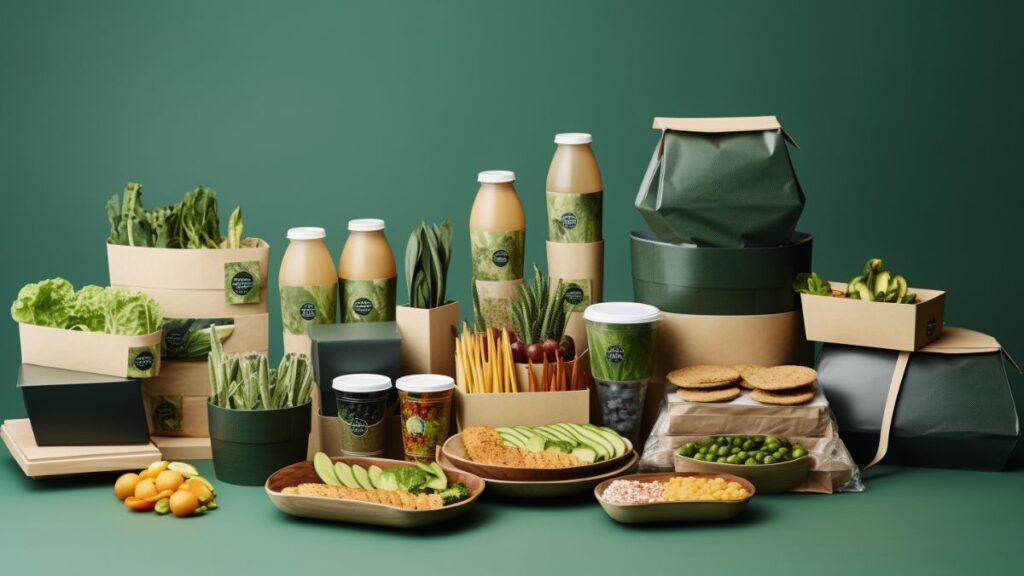
Now that you’ve learned about Vegware and their efforts in eco-friendly foodservice packaging, let’s explore the role of legislation in encouraging sustainable packaging.
Legislation plays a crucial role in promoting and enforcing sustainable practices in the packaging industry. Here are four key ways in which legislation supports eco-friendly packaging:
- Mandatory Recycling Programs: Governments can implement recycling programs that require businesses and individuals to properly sort and recycle their packaging waste.
- Extended Producer Responsibility (EPR): EPR policies hold manufacturers responsible for the entire lifecycle of their products, including the packaging. This encourages them to use more sustainable materials and design packaging that is easier to recycle or compost.
- Bans and Restrictions: Governments can ban or restrict the use of certain types of packaging materials, such as single-use plastics, to reduce their environmental impact.
- Incentives and Tax Breaks: Legislation can provide incentives and tax breaks for businesses that adopt eco-friendly packaging practices, making it financially beneficial for companies to make sustainable choices.
By implementing these legislative measures, governments can create a supportive framework that encourages the adoption of eco-friendly packaging solutions. This transition towards sustainable packaging is essential for reducing waste and mitigating the environmental impact of the packaging industry.
Now, let’s delve into the next section on consumer perception and acceptance of eco-friendly packaging.
Consumer Perception and Acceptance of Eco Friendly Food Packaging
Legislation plays a crucial role in shaping your perception and acceptance of sustainable packaging practices. When governments enact laws and regulations that promote eco-friendly packaging, it sends a powerful message that sustainability is important and necessary.
As a consumer, you have the power to influence the market by choosing products that are packaged responsibly. By supporting brands that prioritize sustainable packaging, you can show that there is demand for these practices. This encourages other companies to follow suit and adopt eco-friendly packaging solutions.
Additionally, legislation can provide incentives for businesses to switch to sustainable packaging by offering tax breaks or subsidies. By actively participating in the movement towards eco-friendly packaging, you can make a positive impact on the environment and contribute to a more sustainable future.
When considering the economic implications of switching to sustainable packaging, it is important to recognize that there may be initial costs involved in transitioning away from traditional packaging materials. However, in the long run, sustainable packaging can actually lead to cost savings for businesses.
By reducing the use of plastics and other non-biodegradable materials, companies can minimize waste disposal and recycling costs. Sustainable packaging can also improve brand reputation and attract environmentally conscious consumers, leading to increased sales and customer loyalty.
Moreover, as more businesses adopt sustainable packaging practices, economies of scale can be achieved, making eco-friendly packaging more affordable for everyone. So, while there may be some short-term challenges, the economic benefits of switching to sustainable packaging far outweigh the costs.
The Economic Implications of Switching to Sustainable Packaging
When considering the economic implications of transitioning to sustainable packaging, you may initially incur costs but can ultimately experience long-term cost savings and improved brand reputation. Making the switch to eco-friendly packaging can have a positive impact on your business in the following ways:
- Cost savings: While sustainable packaging may have higher upfront costs, it can lead to long-term savings. By reducing the need for single-use plastic and investing in reusable or biodegradable materials, you can minimize packaging waste and lower expenses associated with disposal and replacement.
- Improved brand reputation: Consumers are increasingly conscious of their environmental impact and actively seek out brands that align with their values. By adopting sustainable packaging practices, you can enhance your brand’s image as an environmentally responsible company, attracting eco-conscious consumers and fostering loyalty.
- Regulatory compliance: As governments and regulatory bodies implement stricter regulations on plastics and waste management, companies that fail to adopt sustainable packaging may face fines and reputational damage. By proactively embracing eco-friendly alternatives, you can stay ahead of regulatory changes and avoid potential penalties.
By investing in sustainable packaging, you not only contribute to a healthier planet but also set your business up for long-term success. Transitioning to eco-friendly packaging is a smart and responsible choice that can benefit both your bottom line and your brand’s reputation.
As we look ahead to the future of sustainable packaging, trends and predictions indicate a continued focus on innovative materials, waste reduction strategies, and increased consumer demand for eco-friendly options.
Also Read: Eco-Friendly Kitchen: How To Design A Sustainable Dream Kitchen.
The Future of Sustainable Packaging: Trends and Predictions
To stay ahead in the world of sustainable packaging, you should keep an eye on emerging trends and predictions for the future.
One key trend is the increasing demand for eco-friendly materials like glass, stainless steel, bamboo, rice husk, and gelatin films. These alternatives offer reusable, recyclable, and biodegradable options that reduce the environmental impact of packaging.
Additionally, it is important to avoid certain types of plastics, such as those containing harmful additives or single-use plastics that accumulate in oceans and landfills. By cutting down on plastic packaging and choosing companies that prioritize sustainability, we can make a positive impact on the environment and our health.
As we look to the future, it is exciting to see how restaurants and fast food chains are adopting sustainable packaging practices, which we will explore in the next section.
How Restaurants and Fast Food Chains Are Adopting Sustainable Packaging
In the previous subtopic, we explored the future of sustainable packaging and discussed various trends and predictions. Now, let’s shift our focus to how restaurants and fast food chains are actively adopting sustainable packaging practices.
Restaurants and fast food chains play a significant role in the food industry and have the potential to make a substantial impact on the environment. Many establishments are recognizing this responsibility and are taking steps to reduce their environmental footprint through eco-friendly food packaging. They are embracing alternatives to conventional plastic packaging, such as compostable materials made from plant-based sources like sugarcane or cornstarch.
Additionally, some restaurants are transitioning to using reusable containers for takeout orders, reducing the need for single-use packaging altogether. These sustainable packaging initiatives not only contribute to a cleaner environment but also align with the growing consumer demand for eco-friendly options.
Now, let’s delve into the environmental impact of switching to sustainable packaging.
The Environmental Impact of Switching to Sustainable Packaging
By choosing sustainable packaging, you can significantly reduce the accumulation of harmful plastics in the environment and contribute to a healthier planet.
Plastics pose risks to both the environment and human health, with the accumulation of plastics in oceans and landfills being a major concern. This accumulation leads to the generation of micro- and nanoplastics, which can have negative impacts on ecosystems. Moreover, chemicals from packaging can transfer to food, posing additional risks.
However, there are eco-friendly alternatives available. Glass containers, stainless steel, bamboo, rice husk, and gelatin films are all sustainable packaging materials that can be used as alternatives to harmful plastics.
By avoiding conventional plastics, single-use plastics, plastics with BPA, and plastic takeout containers, you can further reduce your plastic consumption.
Related Topic: Green Living: Eco-Friendly Choices For A Sustainable Lifestyle.
Conclusion
So there you have it, my friend! You’ve reached the end of this enlightening journey into the world of eco-friendly food packaging.
Can you picture it now? A world where green truly is the new black, where our meals are not only delicious but also packaged in materials that Mother Earth approves of. Say goodbye to those pesky plastics that harm our environment and health.
Instead, embrace the wonders of glass containers, stainless steel, bamboo, rice husk, and gelatin films. It’s time to cut down on plastic packaging and opt for sustainable alternatives.
And fear not, for there are companies out there leading the way in eco-friendly packaging. Together, we can make a difference and create a future where sustainable packaging is the norm.
So let’s raise our glasses, or should I say glass containers, to a greener and healthier world!
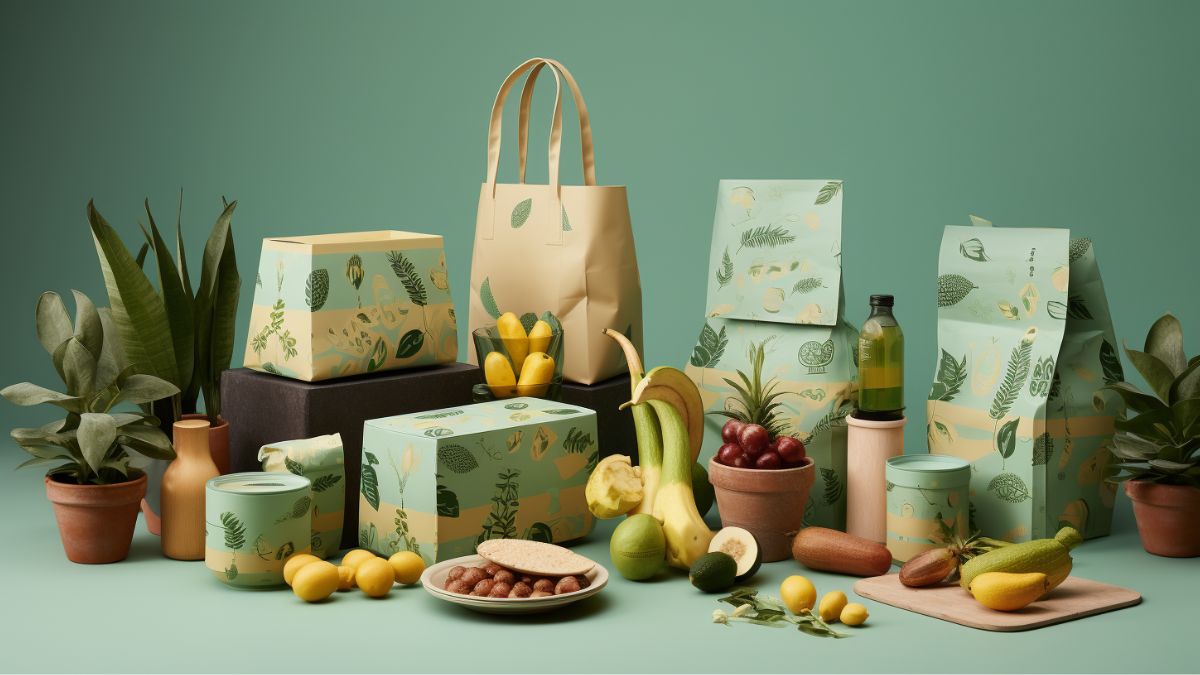


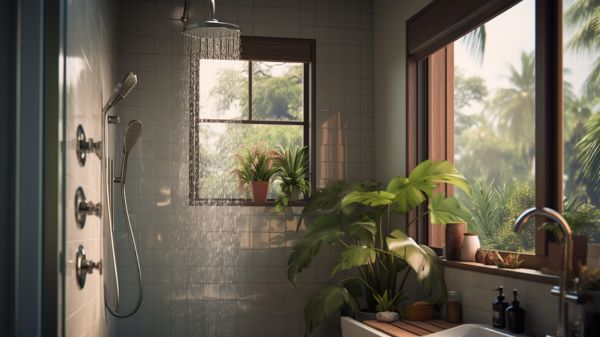


6 Comments
Comments are closed.